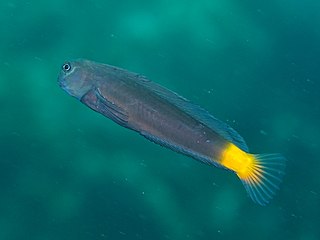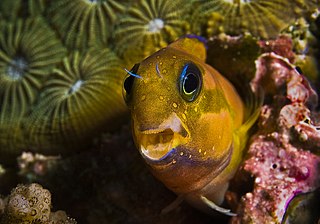
Ecsenius namiyei, commonly called black comb-tooth blenny or Namiye's coralblenny, is a species of marine fish in the family Blenniidae. The specific name honours the Japanese zoologist and museum curator Motoyoshi Namiye (1854-1915).

Ecsenius midas, known commonly as the Midas blenny, Persian blenny, lyretail blenny or golden blenny, is a species of marine fish in the family Blenniidae.
Enteromius cadenati is a species of ray-finned fish in the genus Enteromius which is endemic to the Konkouré basin in Guinea.
Dodekablennos fraseri is a species of combtooth blenny found in the western Indian Ocean, around Réunion and Mauritius. This species is a resident of tide pools where it can be found at depths of from 0 to 2 metres. This species is the only known member of its genus. Its specific name honours Thomas H. Fraser of the Mote Marine Laboratory who collected the type.
Hypleurochilus langi is a species of combtooth blenny found in the eastern Atlantic ocean, from Senegal to the mouth of the Congo River. This species grows to a length of 7 centimetres (2.8 in) SL. This blenny is euryhaline and it enters mouths of large rivers and occurs among mangroves, it prefers brackish water. The specific name of this blenny honours the German zoologist and taxidermist Herbert Lang (1879-1957) of the American Museum of Natural History, who helped to collect the type.
Meiacanthus fraseri is a species of combtooth blenny found in the western Indian Ocean, around Cargados Carajos. This species grows to a length of 5.4 centimetres (2.1 in) SL. Its specific name honours Thomas H. Fraser of the Mote Marine Laboratory who collected the type.

Omobranchus germaini, Germain's blenny, is a species of combtooth blenny found in coral reefs in the western Pacific ocean.
Robert's blenny, Omobranchus robertsi is a species of combtooth blenny found in the western central Pacific Ocean, around Papua New Guinea.
Omobranchus smithi is a species of combtooth blenny found in the western Pacific and Indian oceans.
Omobranchus steinitzi is a species of combtooth blenny found in the western Indian Ocean, in the Red Sea.
Omobranchus woodi, the kappie blenny, is a species of combtooth blenny found in the southeast Atlantic and western Indian Ocean.
Parablennius dialloi is a species of combtooth blenny found in the Eastern and Central Atlantic: Cape Verde to Moçâmedes, Angola. The specific name honours the Senegales curator Amadou Diallo of the Musée de la Mer in Gorée Senegal, who provided specimens to Hans Bath and translated for him while he was working in Senegal.
Parablennius goreensis is a species of combtooth blenny found in the eastern Atlantic ocean. This species reaches a length of 7 centimetres (2.8 in) SL. The specific name refers to the type locality, Gorée, in Senegal.
Parenchelyurus hyena, the hyena blenny, is a species of combtooth blenny found in the western Pacific ocean, around Papua New Guinea.

Ecsenius alleni, known commonly as the Allen's blenny, is a species of combtooth blenny in the genus Ecsenius. It is found in coral reefs in the eastern Indian Ocean, specifically in western Australia. It can reach a maximum length of 3.4 centimetres. The blennies feed primarily off of plants and algae. The specific name honours the ichthyologist Gerald R. Allen.
Ecsenius collettei, known commonly as the Collete's blenny in Papua New Guinea, is a species of combtooth blenny in the genus Ecsenius. It is found in coral reefs in the western central Pacific ocean, specifically in Papua New Guinea. It can reach a maximum length of 5 centimetres. The blennies feed primarily off of plants, and benthic algae and weeds. he specific name honours Bruce B. Collette the Director of the National Marine Fisheries Service Systematics Laboratory, whose collection of fish specimens from New Guinea contained a number important blenniid specimens, one of which was this species.
Ecsenius lubbocki, the Lubbock's combtooth-blenny, is a species of combtooth blenny in the genus Ecsenius. It is found in coral reefs in Phuket, Thailand, in the eastern Indian Ocean. It can reach a maximum length of 4 centimetres. Blennies in this species feed primarily off of plants, including benthic algae and weeds. The specific name honours the English marine biologist Hugh Roger Lubbock (1951–1981), the collector of the type specimens, he recognised that they were a new species of Ecsenius.
Gobius senegambiensis is a species of marine fish from the family Gobiidae, the true gobies. It is native to the Atlantic Ocean from Morocco to Angola as well as the islands in the Gulf of Guinea. It is found in inshore waters on sandy bottoms. This species can reach a length of 7.3 centimetres (2.9 in) SL.
Coloconger cadenati is an eel in the family Colocongridae. It was described by Robert H. Kanazawa in 1961. It is a marine, deep-water dwelling eel which is known from Senegal to the Gulf of Guinea in the eastern Atlantic Ocean. It is known from a depth range of 270–600 m. Males can reach a maximum total length of 90 cm. The diet of C. cadenati consists primarily of benthic crustaceans.
Opeatogenys cadenati is a species of clingfish from the family Gobiesocidae. It occurs in the eastern Atlantic and has been recorded off Ghana, Senegal and Morocco, as well as off the Canary Islands. This species was described by John C. Briggs in 1957 with a type locality of Chenal de Joal off Senegal. Briggs honoured the French ichthyologist Jean Cadenat (1908-1992) who was Director of the Marine Biological Section of the Institut Français d’Afrique Noire in Gorée, Senegal.




